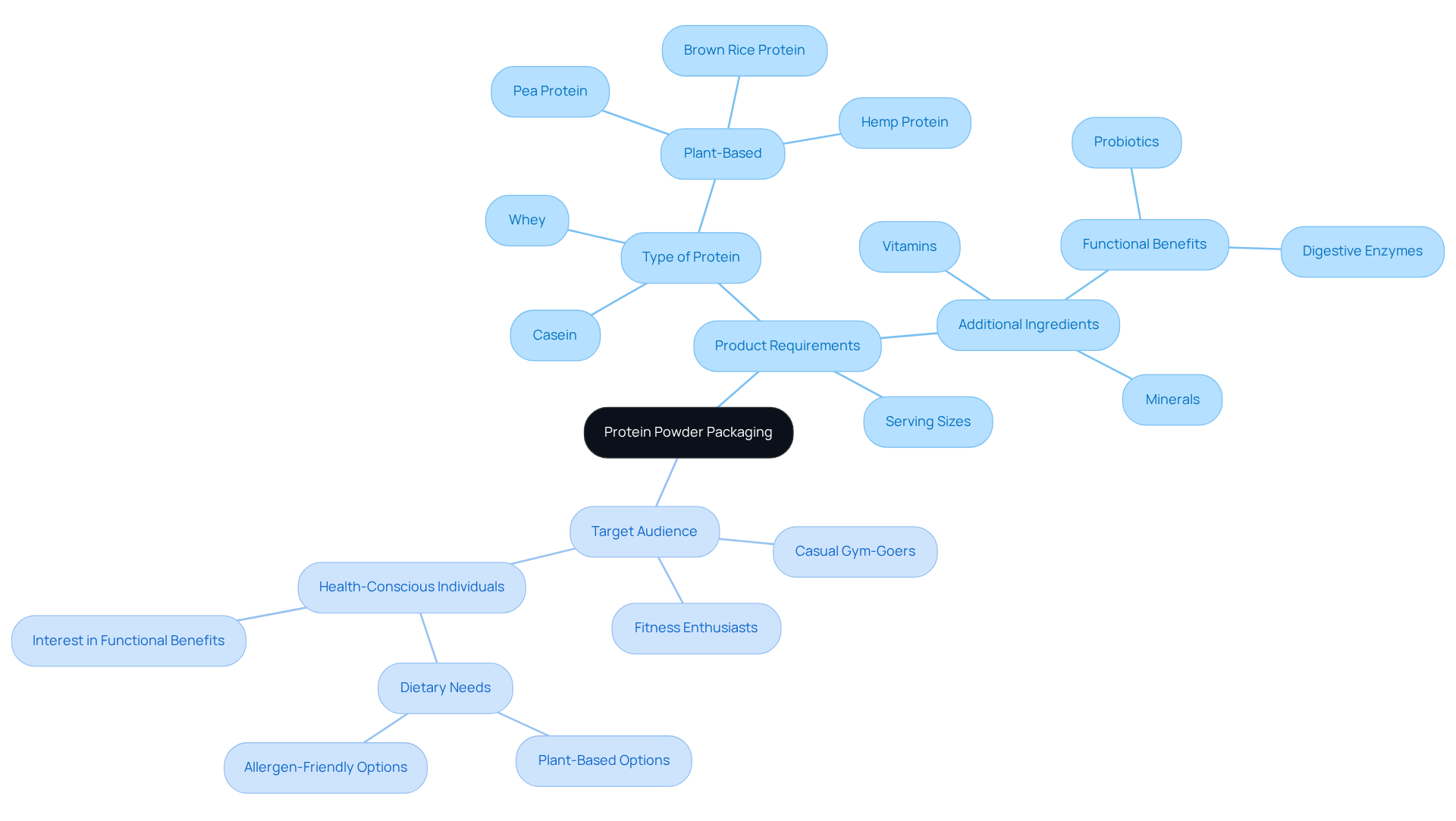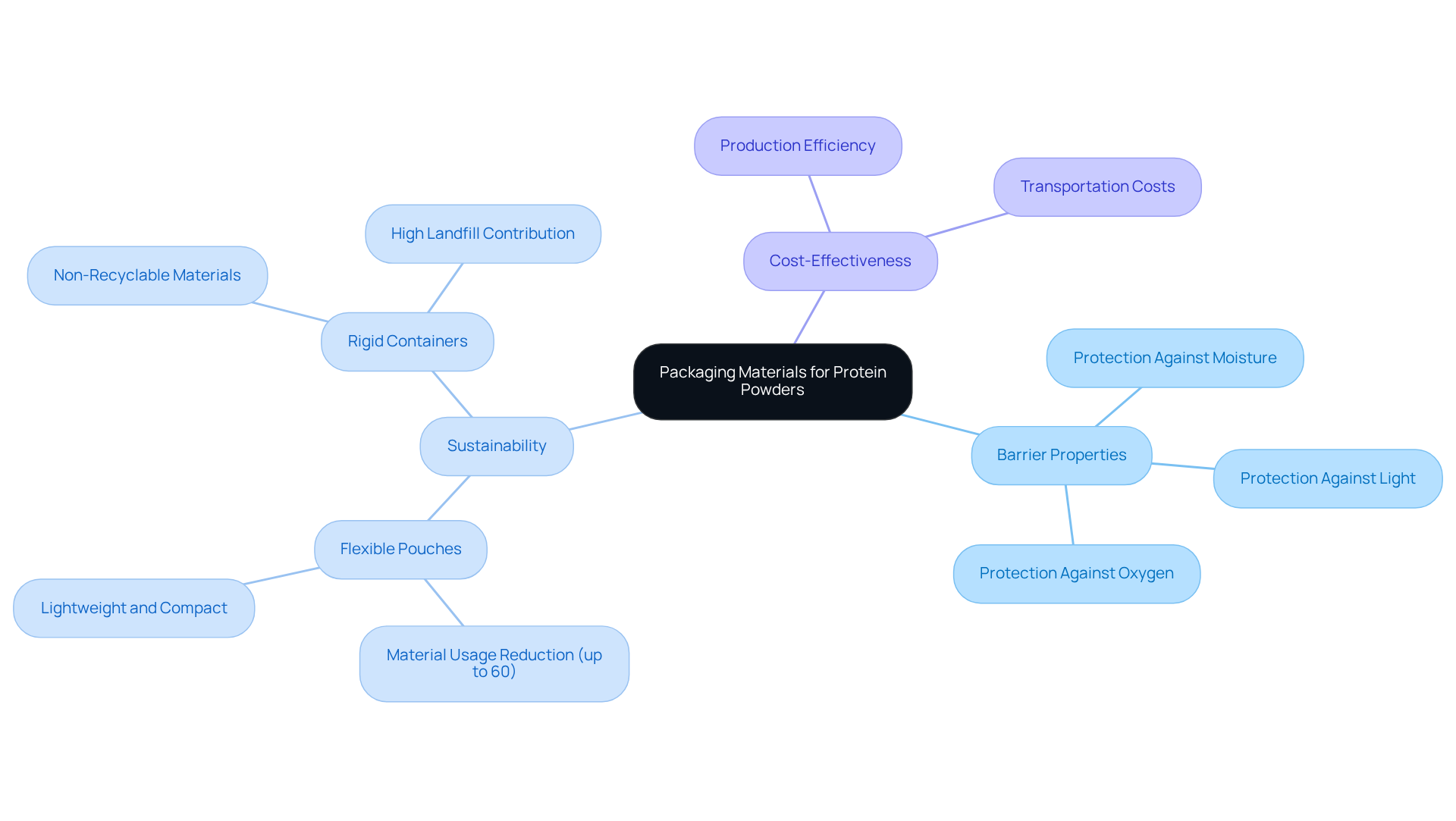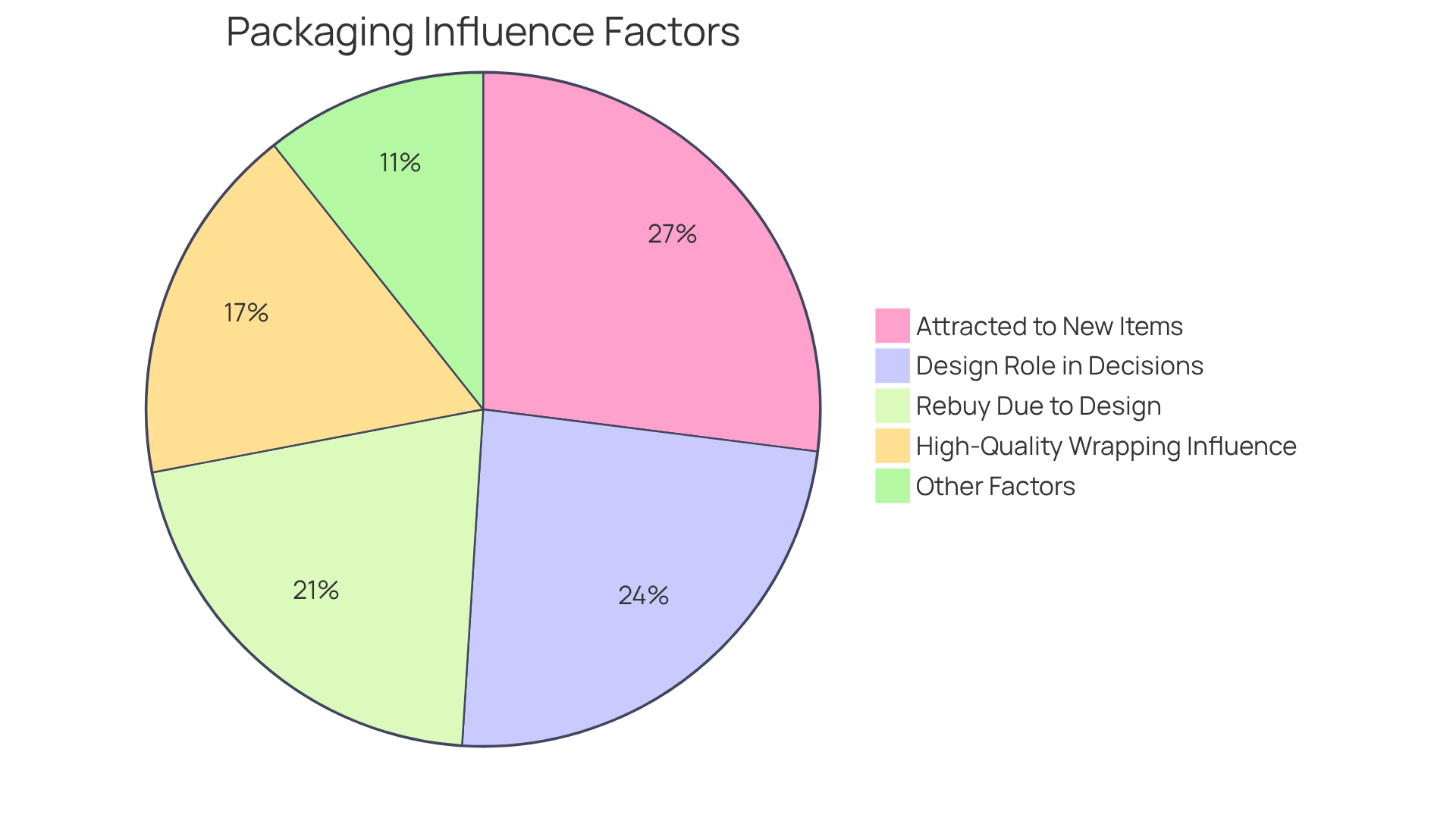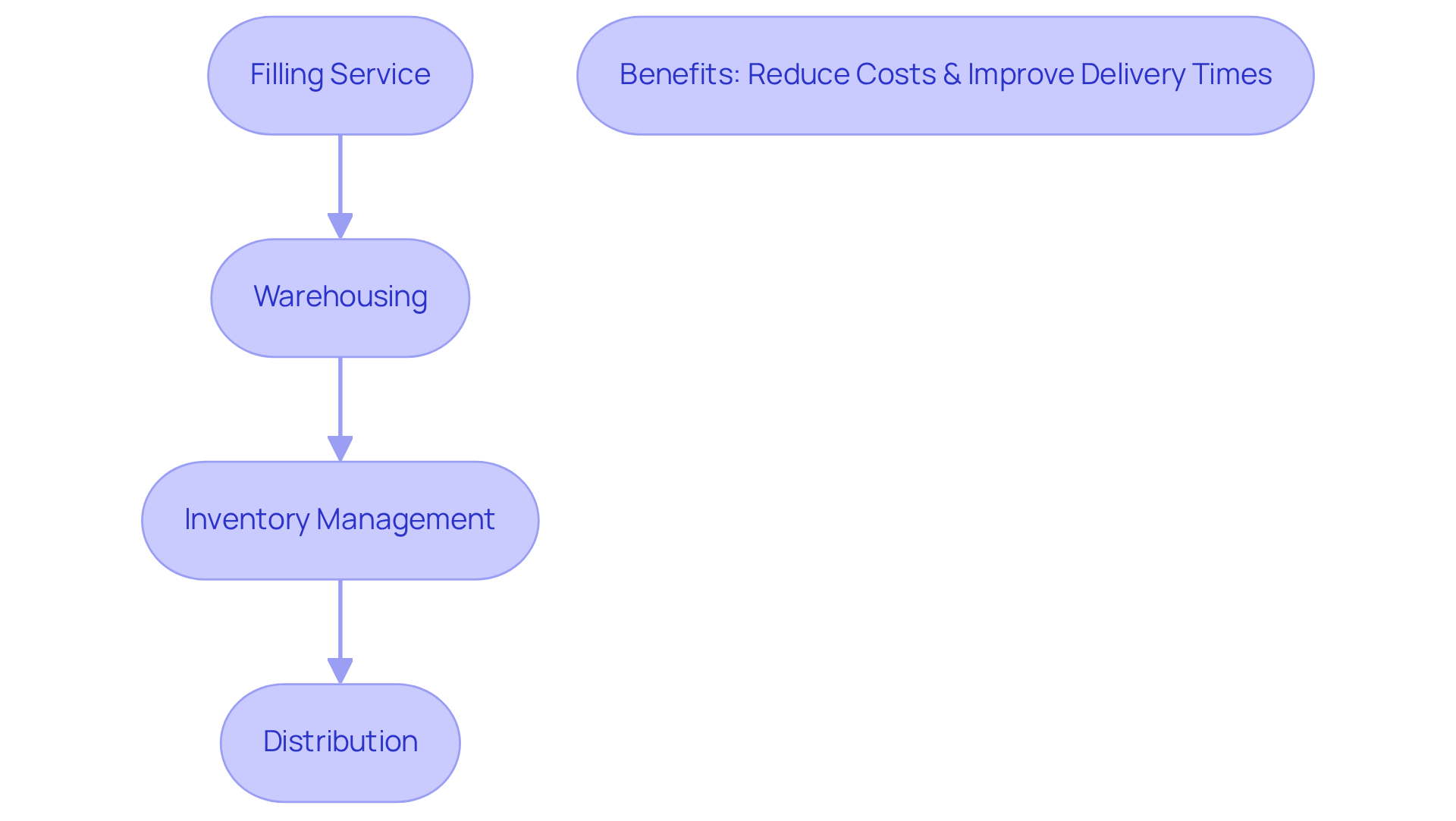Overview
This article delineates four fundamental steps to optimize protein powder packaging, emphasizing:
- The identification of product requirements and target audience
- The selection of suitable materials
- The design for brand impact
- The integration of efficient filling and distribution solutions
Each step underscores the significance of market research, sustainability, and effective branding to elevate product appeal and fulfill consumer expectations. Consequently, this approach positions brands competitively within the expanding protein supplement market.
Introduction
The protein powder market is experiencing significant growth, with projections indicating an increase from $24.8 billion to $45.6 billion by 2034. This expansion is largely driven by health-conscious consumers who are actively seeking tailored nutritional solutions.
As this sector continues to evolve, the significance of effective packaging cannot be overstated—it serves not only to protect the product but also to attract and retain customers.
How can brands effectively navigate the complexities of packaging design, material selection, and logistics to distinguish themselves in a crowded marketplace?
This guide outlines four essential steps to optimize protein powder packaging, ensuring it meets consumer demands while enhancing brand visibility and sustainability.
Identify Your Product Requirements and Target Audience
To enhance your protein powder packaging, start by thoroughly evaluating the specific needs of your product. Key considerations include the type of protein—whether whey, casein, or plant-based—along with serving sizes and any additional ingredients like vitamins or minerals. Understanding these components is essential for developing packaging for protein powder that not only protects the product but also attracts buyers.
Next, clearly define your target audience. Are you focusing on fitness enthusiasts, casual gym-goers, or health-conscious individuals? Conducting comprehensive market research is crucial to uncover their preferences, purchasing behaviors, and pain points. For instance, the protein supplement market is projected to grow from USD 24.8 billion in 2025 to USD 45.6 billion by 2034, at a compound annual growth rate (CAGR) of 7%, driven by increasing health awareness and the adoption of high-protein diets. This growth indicates a diverse clientele that values customized solutions.
Data reveals that consumers are increasingly seeking protein supplements that cater to specific dietary needs, such as plant-based and allergen-friendly options. Furthermore, there is a rising interest in protein powders with functional benefits, including probiotics and digestive enzymes, which enhance their appeal to health-conscious consumers. By understanding these preferences, you can make informed decisions about protein powder packaging that resonates with your target market and effectively communicates the product's benefits. This strategic approach not only boosts the attractiveness of your offerings but also positions your brand favorably in a competitive landscape.

Choose the Right Packaging Materials for Protein Powders
Choosing the appropriate protein powder packaging materials is essential for preserving the quality of protein products and fulfilling buyer expectations. Key considerations include barrier properties, sustainability, and cost-effectiveness. Flexible pouches stand out as an ideal option due to their lightweight quality and resealable attributes, enhancing user convenience. These pouches can be engineered to provide superior protection against moisture, light, and oxygen—critical factors in maintaining the quality of protein powder packaging.
Sustainability is increasingly vital in the decision-making process, as buyers gravitate towards brands that prioritize environmentally friendly materials. Traditional rigid containers, often crafted from non-recyclable materials, contribute significantly to landfill waste and escalate transportation energy consumption. In contrast, protein powder packaging in flexible pouches can reduce material usage by up to 60%, aligning with the industry's growing demand for sustainable practices.
Successful examples of sustainable packaging involve the integration of advanced technologies, such as the Auto Pouch Bagger AP-140. This innovation not only boosts efficiency but also minimizes waste through precise filling capabilities. Such an approach supports sustainability goals while enabling brands to maintain competitive pricing without compromising quality. By selecting innovative container solutions, manufacturers can effectively attract environmentally conscious buyers while ensuring their products remain fresh and shelf-stable.

Design Packaging for Maximum Brand Impact
To maximize brand impact, design your packaging to authentically reflect your brand identity and resonate with your target audience. Utilize colors, fonts, and imagery that embody your brand values and align with the lifestyle of your audience. Clear and concise messaging is essential; highlight the unique benefits of your protein powder packaging, such as its nutritional profile and sourcing practices. Incorporating informative components such as usage guidelines, nutritional details, and certifications (e.g., organic, non-GMO) promotes trust and transparency with buyers. A well-crafted protein powder packaging not only captures attention but also conveys quality and reliability, significantly influencing purchasing decisions.
Studies show that:
- 72% of shoppers think that the design of protein powder packaging plays an essential role in their purchasing decisions.
- 63% have bought an item again specifically because of its attractive protein powder packaging design.
- 81% of shoppers have purchased a new item because the presentation attracted their attention.
- 52% of clients are more inclined to buy from an online seller again if they receive their goods in high-quality wrapping.
By incorporating effective branding into your products, you can enhance brand recognition and loyalty, ultimately driving sales in the competitive nutraceutical market.

Integrate Filling and Distribution Solutions for Efficiency
To enhance your protein powder packaging, it is essential to collaborate with a reliable filling service that aligns with your specific requirements. The filling process must be compatible with the design and materials of your protein powder packaging. Furthermore, consider the comprehensive third-party logistics (3PL) solutions offered by Western Packaging, which encompass:
- Warehousing
- Inventory management
- Distribution
Our tailored services are meticulously designed to bolster your supply chain efficiency, ensuring product integrity while meeting consumer demand promptly. By integrating these processes, you can significantly reduce operational costs and improve delivery times, ultimately elevating customer satisfaction.

Conclusion
Optimizing protein powder packaging represents a multifaceted process that hinges on a deep understanding of product requirements and target audiences. By thoroughly evaluating the type of protein, serving sizes, and consumer preferences, brands can develop packaging that not only protects the product but also resonates with the specific needs of their market. This strategic approach is essential in a rapidly growing industry where personalized solutions are increasingly valued.
Key insights from this guide underscore the significance of:
- Selecting appropriate materials
- Emphasizing sustainability
- Designing packaging that connects with consumers
The choice of flexible pouches, for example, not only enhances product preservation but also aligns with the growing demand for environmentally friendly options. Furthermore, effective branding and clear messaging can significantly influence purchasing decisions, showcasing the product's unique benefits and fostering trust among consumers.
Ultimately, the integration of efficient filling and distribution solutions is vital for maintaining product integrity and ensuring customer satisfaction. By prioritizing these elements, brands can enhance their market position while contributing to a more sustainable future. Embracing these best practices in protein powder packaging will not only meet consumer demands but also drive growth in a competitive landscape, making it imperative for manufacturers to adapt and innovate continuously.
Frequently Asked Questions
What should I consider when identifying product requirements for protein powder packaging?
Key considerations include the type of protein (whey, casein, or plant-based), serving sizes, and any additional ingredients like vitamins or minerals.
Why is it important to define my target audience for protein powder?
Defining your target audience helps you understand their preferences, purchasing behaviors, and pain points, which is crucial for developing effective packaging that attracts buyers.
What are the projected growth trends in the protein supplement market?
The protein supplement market is projected to grow from USD 24.8 billion in 2025 to USD 45.6 billion by 2034, with a compound annual growth rate (CAGR) of 7%, driven by increasing health awareness and high-protein diet adoption.
What specific dietary needs are consumers looking for in protein supplements?
Consumers are increasingly seeking protein supplements that cater to specific dietary needs, such as plant-based and allergen-friendly options.
What functional benefits are gaining interest among health-conscious consumers?
There is a rising interest in protein powders that include functional benefits like probiotics and digestive enzymes, enhancing their appeal to health-conscious consumers.
How can understanding consumer preferences impact my protein powder packaging?
By understanding consumer preferences, you can make informed decisions about packaging that resonates with your target market and effectively communicates the product's benefits, improving attractiveness and competitive positioning.




